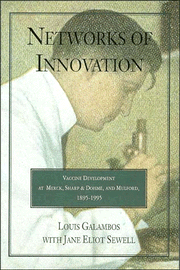Book contents
- Frontmatter
- Contents
- PREFACE
- 1 1894: “The foremost medical question of the day”
- 2 The Mulford Story
- 3 A Sharp & Dohme Interlude
- 4 The Virology Network and a New Program at Merck Sharp & Dohme
- 5 Hilleman's Innovations: First Phase
- 6 Dangerous Interlude
- 7 Transforming Bacteriology: A Second Phase
- 8 New Networks, New Leadership: The Hepatitis B Vaccines
- 9 Vaccine Innovation in the Nineties: New Strategies, New Opportunities, and Public Confrontations
- 10 Historical Perspectives on the Process of Innovation
- ACKNOWLEDGMENTS
- A WORD ABOUT SOURCES
- INDEX
- Plate section
2 - The Mulford Story
Published online by Cambridge University Press: 06 July 2010
- Frontmatter
- Contents
- PREFACE
- 1 1894: “The foremost medical question of the day”
- 2 The Mulford Story
- 3 A Sharp & Dohme Interlude
- 4 The Virology Network and a New Program at Merck Sharp & Dohme
- 5 Hilleman's Innovations: First Phase
- 6 Dangerous Interlude
- 7 Transforming Bacteriology: A Second Phase
- 8 New Networks, New Leadership: The Hepatitis B Vaccines
- 9 Vaccine Innovation in the Nineties: New Strategies, New Opportunities, and Public Confrontations
- 10 Historical Perspectives on the Process of Innovation
- ACKNOWLEDGMENTS
- A WORD ABOUT SOURCES
- INDEX
- Plate section
Summary
PHILADELPHIA had a well-established pharmaceutical industry in the nineteenth century, but it was not at all clear that one of the city's firms would become the early commercial leader in the biological network that was beginning to develop in the United States. Nor was the H. K. Mulford Company the obvious choice to be the first firm to bring a new serum treatment for diphtheria to market. Other firms in Philadelphia had been in the business longer, were larger, had greater resources, and should no doubt have led the way in developing this new capability. New York City – the other leading medical center in the United States – also had a number of pharmaceutical producers. They had the advantage of proximity to the Board of Health's Division of Pathology, Bacteriology, and Disinfection, one of the formative organizations in this particular network.
In this instance, however, neither abundant resources nor location appeared to convey any significant commercial advantages, but the entrepreneurial instincts of Mulford's president and vice president did. The vice president, Henry K. Mulford, had established the firm in the late 1880s, when he purchased the “Old Simes” drugstore at the corner of 18th and Market Streets in downtown Philadelphia. The drugstore, which dated back to 1815, had been operated by two well established pharmacists, Joseph L. Remington and Lucius P. Sayre. Remington was dean of the Philadelphia College of Pharmacy and had published a text, Remington's Practice of Pharmacy, that went through sixteen editions after its initial appearance in 1885. After selling the store to Mulford, his former employee, Sayre became dean of the College of Pharmacy at the University of Kansas.
- Type
- Chapter
- Information
- Networks of InnovationVaccine Development at Merck, Sharp and Dohme, and Mulford, 1895–1995, pp. 9 - 32Publisher: Cambridge University PressPrint publication year: 1996



